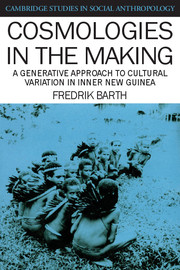Book contents
- Frontmatter
- Contents
- Foreword by Jack Goody
- Map: Major territories of the mountain Ok
- 1 The problem
- 2 An attempt at systematic comparison: descent and ideas of conception
- 3 The possible interrelations of sub-traditions: reading sequence from distribution
- 4 The context for events of change
- 5 The results of process – variations in connotation
- 6 Secret thoughts and shared understandings
- 7 The stepwise articulation of a vision
- 8 Experience and concept formation
- 9 The insights pursued by Ok thinkers
- 10 General and comparative perspectives
- 11 Some reflections on theory and method
- Bibliography
- Index
- Cambridge Studies in Social Anthropology
4 - The context for events of change
Published online by Cambridge University Press: 05 June 2012
- Frontmatter
- Contents
- Foreword by Jack Goody
- Map: Major territories of the mountain Ok
- 1 The problem
- 2 An attempt at systematic comparison: descent and ideas of conception
- 3 The possible interrelations of sub-traditions: reading sequence from distribution
- 4 The context for events of change
- 5 The results of process – variations in connotation
- 6 Secret thoughts and shared understandings
- 7 The stepwise articulation of a vision
- 8 Experience and concept formation
- 9 The insights pursued by Ok thinkers
- 10 General and comparative perspectives
- 11 Some reflections on theory and method
- Bibliography
- Index
- Cambridge Studies in Social Anthropology
Summary
To do so, I must break out of the mold I have followed in the preceding chapter when setting up my problem and line of argument. I suggest that we here, as so often, can take a cue from Darwin. His strategy was to focus, in the tradition of the wondering naturalist, on small parts of the picture, closely observed and revealingly interpreted. He did not reach directly for the overall pattern in a myriad of forms, or the general shape and direction of phylogenies. Whether in the courting disply of golden pheasants (Darwin 1871:728) or the relations of beak form, environment, and feeding habits of Galapagos finches (Darwin 1843: 373) he looked for generalizable features in the particular situation which might give cumulative direction to small increments of change. In other words, he sought to extract generalizable mechanisms and processes from his particulars.
Can we achieve something similar? Let me start with a scene from the temple in Bolovip. For a while during February 1982 I spent some hours every day there obtaining detailed descriptions of the rituals at each level of their nine-step initiation. Three persons participated from the Bolovip side: the former leader of the Yolam (the more recent leader had some days previously died in an accident during a sacred hunt), the senior man of the Katiam, and one other senior man.
- Type
- Chapter
- Information
- Cosmologies in the MakingA Generative Approach to Cultural Variation in Inner New Guinea, pp. 24 - 30Publisher: Cambridge University PressPrint publication year: 1987



